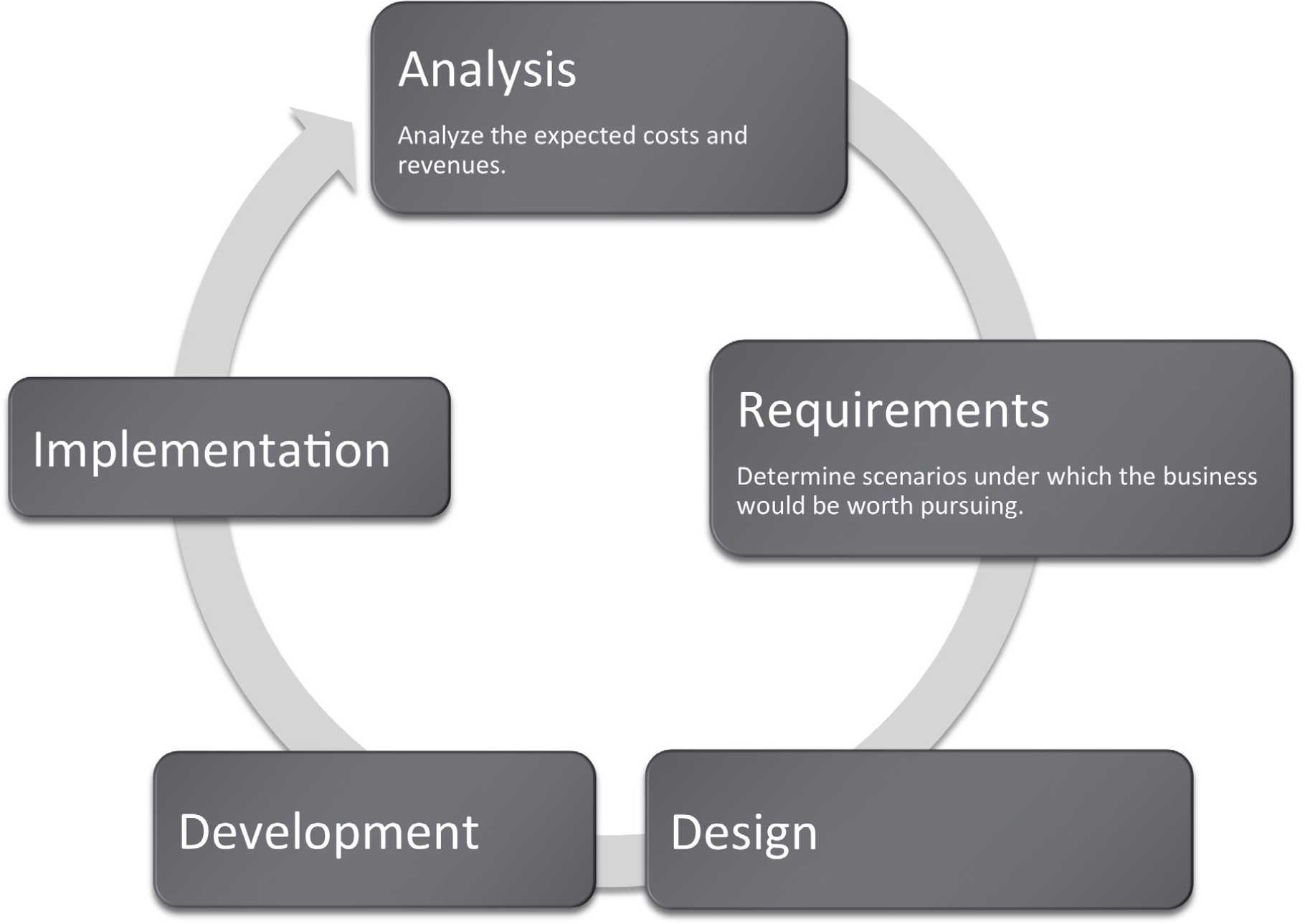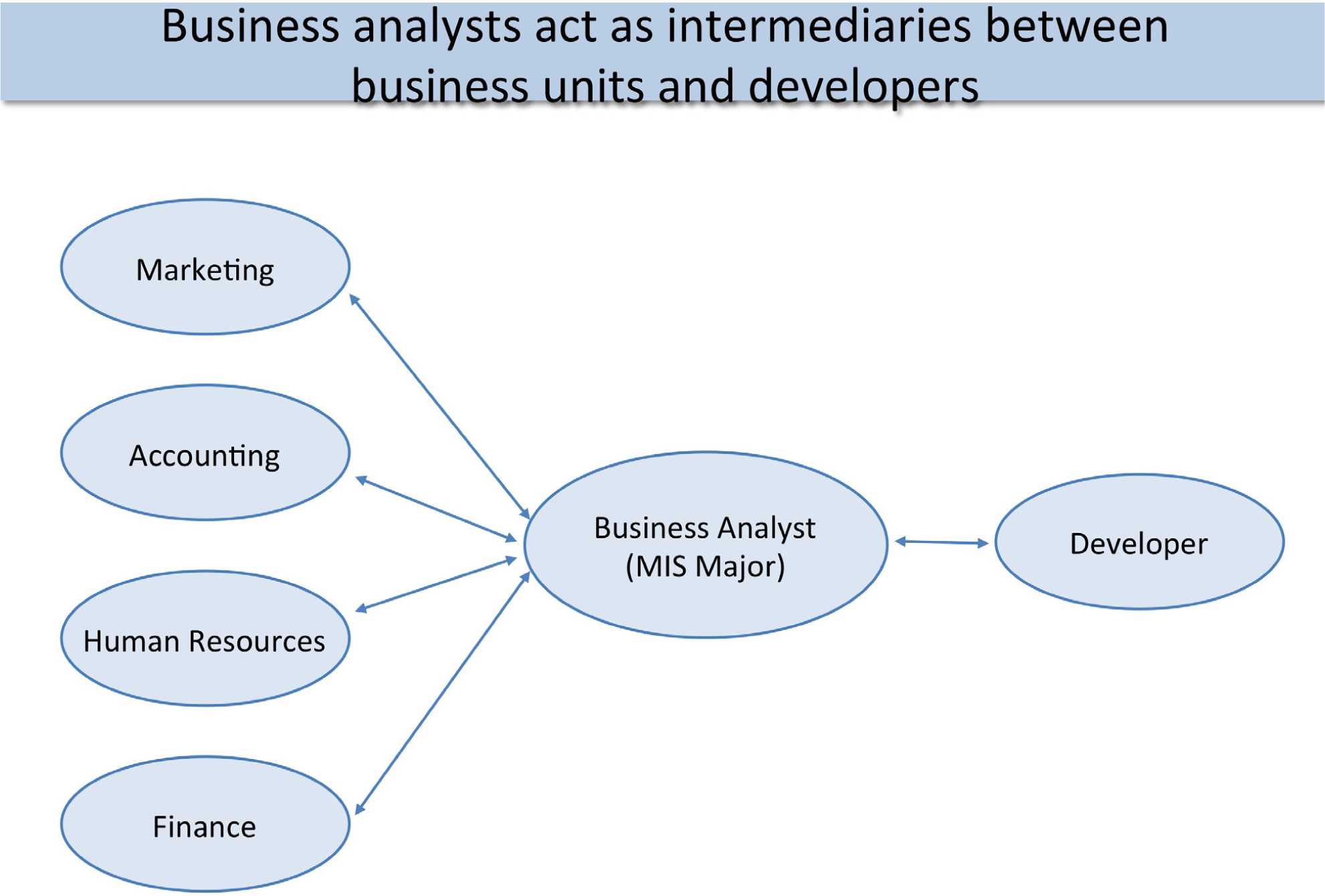In this chapter we will look at the costs and revenues involved in bringing your app to market. The steps involved in bringing an app to market include:
Note that you have already completed steps 1 to 3 and even part of step 7! We have stopped short only of the steps that actually cost money. In this chapter we will look at what those costs are and how to manage them in a spreadsheet.
Many information systems projects are conceived of in a life cycle that progresses in stages from analysis to implementation. The diagram below shows the stages that we touch in the current chapter:

To actually program an iPhone app requires fairly extensive programming knowledge. Apps are programmed in a language called objective C. This is beyond the scope of most information systems (IS) business analystsThis is a job title typical for an IS graduate. Business analysts work both with business units such as Human Resources and the programmers. They discover the needs of the business unit and then translate those needs into documentation for the programmers. Business analysts also test the completed system and supervise its roll out.. IS professionals hire the programmers, rather than doing the coding themselves. In fact, most IS curricula teach programming only so that the business analyst is able to communicate effectively with programmers by speaking a bit of their language and understanding some of their constraints.
Within a large corporation there will typically be a team of developers (usually computer science majors) and a team of business analysts (usually IS majors). The business analysts communicate with the business units, such as marketing or finance, to analyze the business needs. They then translate those needs into requirements that are delivered to the developers. The process flows, mockups, and market descriptions that you have done in earlier chapters are all part of those requirements.
The developers program the application and then deliver it back to the business analysts for testing. In this way, IS professionals serve as the bridge between the developers and the business units.
The business analyst’s job continues even after the app is developed. They test the app extensively when it is delivered back from the developer.
Most of the iPhone apps with which you are familiar are designed for the consumer market. However, there are a number of corporations that design in-house proprietary iPhone apps for their employees. If you were designing your app for a company you would serve as the intermediary between the business unit and the developers.

IS professionals typically serve in the role of a business analyst. They find out the requirements of the business unit and then translate those requirements into documentation that the programmers can work with.
Some corporations, especially small ones, do not retain a team of developers. They rely on the ability to contract out development work.
With the advent of the web, the process of locating programmers has become much easier. There are a number of portals such as Elance.com that allow you to auction off your job much the same way that you would auction a product on eBay. Developers then bid on your job and you select your preferred developer. To help you in the decision, these services also maintain ratings of developers based on feedback from prior clients.
The process of bidding out a job to a developer outside of your corporation is called outsourcingHiring another firm to do a job that traditionally might have been done in-house.. Outsourcing comes in two flavors depending on where the developer is located. Outsourcing to a local developer is called onshoringOutsourcing to a firm that resides in your own country.. Outsourcing to a developer in another country is called offshoringOutsourcing to a firm that resides in a foreign country.. Offshoring is a popular movement among North American companies due to the high cost of skilled labor in the United States. Many developers live offshore in countries such as India, Pakistan, Russia, and Brazil.
One key factor in outsourcing is communicating clearly with the developer. Any documentation that you prepare in advance helps reduce the possibility of misunderstandings. That is why we spent time planning the app and constructing a mockup.
Choosing a developer is not about getting the lowest price, but rather about getting the best value. You want a good developer, but maybe you do not need the best. Make sure that your developer has a reputation for delivering on time and within budget. Furthermore, you often get what you pay for. Cheaper developers may deliver lower quality.
There is a myth of developers in third world countries working practically for free. However, as countries such as India, Pakistan, and Russia become wealthier, the wages rise.
The offshoring process is imperfect and some U.S. companies have found that documentation requirements are so extensive, and communication problems so prevalent, that it is almost cheaper in the end to hire a local programmer somewhat familiar with the business already. Some portals, such as iPhoneAppQuotes.com, advertise on-shoring as their competitive advantageAn attribute that allows a firm to best the competition in some way..
Many companies provide iPhone quotes. Elance.com is more general and worldwide, developing lots of different kinds of systems with developers all over the world. iPhoneAppQuotes.com develops iPhone apps using only developers in the United States.
Sometimes students resist the process of estimating costs since there is so much uncertainty in the variables. Uncertainty is normal in business and is accepted by investors. The solution is to proceed with good faith estimates and perhaps produce a range of possible outcomes dependent on positive and negative scenarios.
Uncertainty implies risk. In the negative scenario, you might lose everything and go out of business. On the other hand, in the positive scenario, you might do very well. Fortunately, there are always people willing to take the risk to bring new products to market.
Below you will find a summary of the costs involved in creating an iPhone app. Note that we are not including the value of your time to conceive, document, and test the app. Like many entrepreneurs you will be working for free.
Legal costs: If your business has a name other than your own, then by law you must file for a Doing Business As (DBA)The cheapest way to start a business. It is just you doing business under another name. However, you are personally liable for business debts. license. However, that license does not protect you from liability. You are still personally liable for the debts of your business. A safer but more expensive option is to set up a Limited Liability Corporation (LLC)Usually the recommended way to start a small business. If the business goes under, you are not personally liable for the businesses debts.. The LLC offers some protection from personal liability. We are picking relatively inexpensive options though you may want to add the cost of an attorney to your estimates.
Developer costs: Your greatest cost will be to pay the developer. Avoid being too cheap here or the entire project will fail. To register and test your app with iTunes requires that you have an Apple Developer license. So even though you are not the developer, still you need to register as an Apple developerA developer registered with Apple. Only Apple developers can list apps on the iTunes store..
Marketing costs: Finally, you need to promote your app. You have already created a web site to which you can direct traffic. But ultimately people have to find out about you. App review sites such as AppVee.com offer advertising packages for around $200/month.
All of the above are fixed costsA cost that the business must pay whether or not they sell anything. Examples include rent, legal fees, development costs and so forth.. You have to pay them whether you sell one app or 10,000. However, you also have a variable costA cost that business incurs on each sale. For apps, the variable cost is the iTunes store commission. from Apple. Apple takes 30% of every sale on iTunes. This is for the privilege of selling your app in their store. Since they are the only store allowed to sell apps, you do not really have a choice. So if your app costs $2.00, Apple gets $0.60 for each app sold. You make $1.40 per sale.
What you make per unit after subtracting variable costs is called the contribution marginWhat you make on every sale after subtracting variable costs.. Knowing the contribution margin helps you quickly calculate your total revenue—simply multiply contribution margin by the number of units sold.
Table 7.1
| Various Fixed Costs | Amount | |
|---|---|---|
|
Doing Business As (DBA) or Limited Liability Corporation (LLC) license from a service such as LegalZoom.com |
$199 |
|
|
Outsourcing development from a portal such as Elance |
$3,500 |
|
|
Maintenance and updates from developer after year 1 |
$1,000/year |
|
|
Apple Developer license |
$99/year |
|
|
Ad on app review sites such as AppVee.com |
$2,400/year |
|
|
TOTAL FIRST YEAR |
$6,098 |
Some costs of doing business shown above. Legalzoom.com is one of the less expensive ways to incorporate.
The concept of variable costs is essential to predicting profitability. Put quite simply, you do not make any money unless you sell a lot of apps. Therefore, we will spend some effort trying to understand variable costs both conceptually and in a spreadsheet.